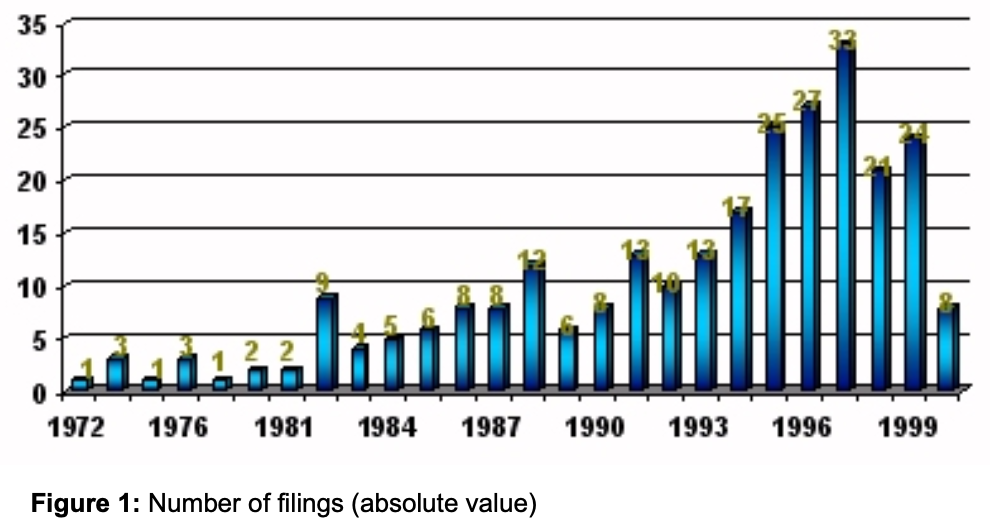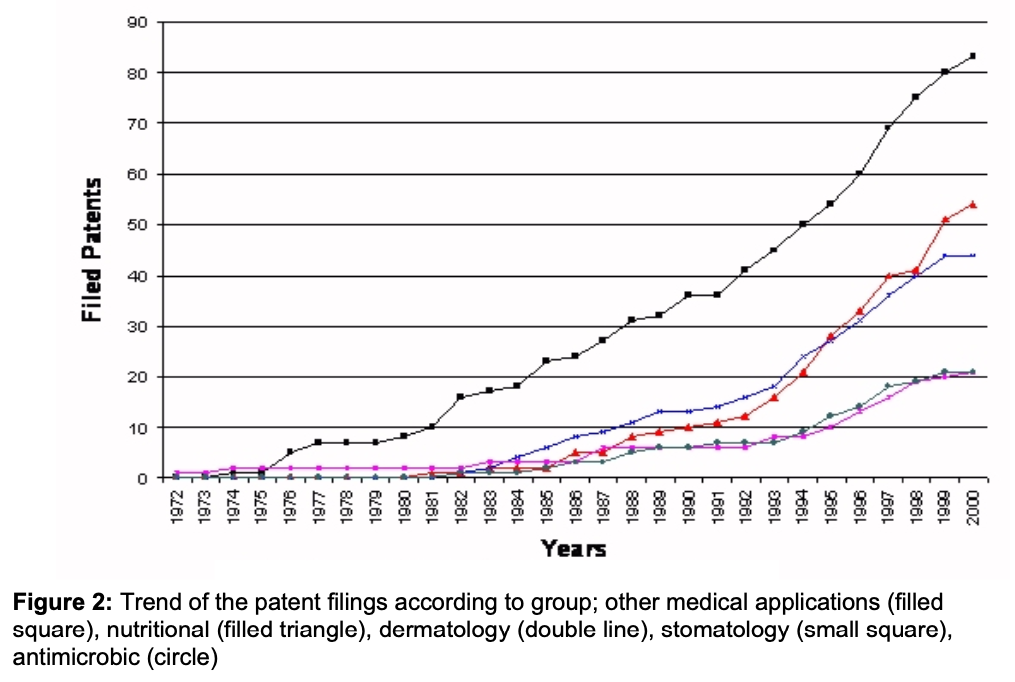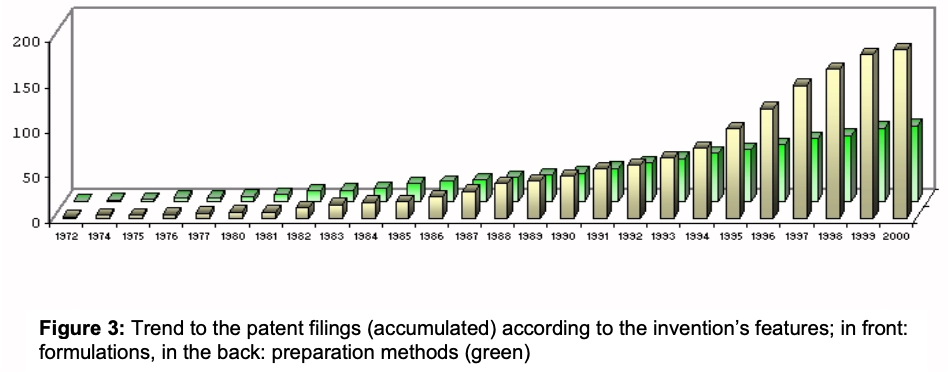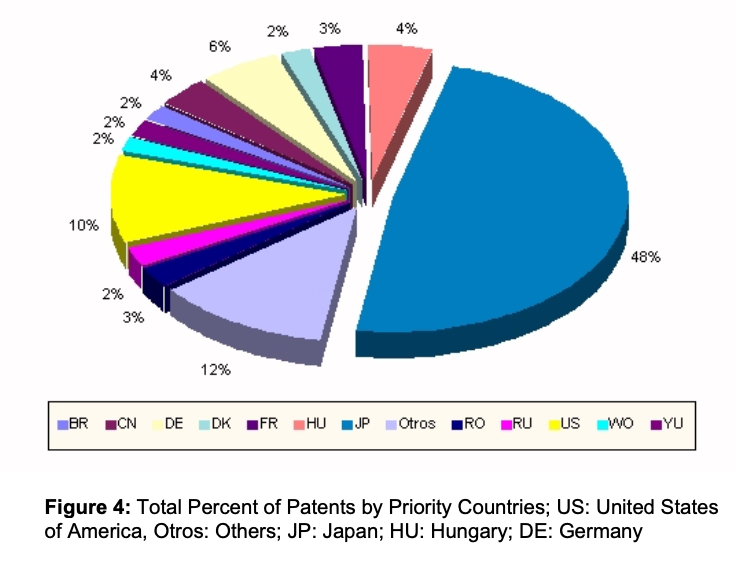Propolis: Patents and technology trends for health applications
Abstract: In this paper are shown the main trends for the use of propolis based on the patent or invention documents. Information is given on the owners, innovators, international patent classification, subject groups and priority countries. The obtained results show that propolis is a natural product of interest for the current technological and scientific world, since the innovation capability has been kept in the subjects studied in this work. There is remarkable work on the application of propolis for treatment and care of skin. Japan is known to be the leading country in the use of propolis in health care.
Introduction
Propolis is manufactured by bees from the sap of trees and flower blossoms. Propolis protects the beehive from penetration of harmful insects and aids in insulating the beehive, and maintaining a sterile environment.
Many studies have proven propolis[1] effectiveness in fighting viruses, bacteria and fungi, and as an anti-inflammatory agent. Propolis is known as Nature’s Antibiotic, capable of fighting pathogenic (disease causing) bacteria, as opposed to conventional antibiotics which destroy all the body’s natural flora. In addition, bacteria do not become resistant because many natural factors (the sap source, climate and geographical region) all indiscernibly yet significantly continually alter the natural composition.
Propolis strengthens the body’s resistance to winter’s ailments: infections, flu and colds. Propolis can be used externally to heal cuts, torn tissues and burns (up to second degree) and for surgical scars. Propolis has been found to be effective in the treatment of gum and mouth infections. It has been used for centuries as a folk remedy and has only in recent years been “re- discovered” by science resulting in comprehensive research regarding the active ingredients of propolis and its antibacterial properties [1].
The many functions of propolis include: nourishes face, postpones senility, softens blood vessels, purifies the blood, promotes reproduction of tissue, accelerates healing of injuries, refreshes vital energy, improves function of stomach and intestines, overcomes constipation, decreases blood fat and blood sugar, kills bacteria, fungus, and virus, improves capillary circulation, eliminates toxins [2].
Propolis helps regulate hormones and is an antibiotic substance that stimulates the natural resistance of the body. Propolis may be used by everyone, sick or healthy, as a means of protection against micro-organisms. Propolis is also efficient against conditions caused by bacteria, viruses of different fungi. It cures many diseases because it is a special natural substance with strong effect. The whole research program had a single purpose, namely, to investigate this substance against the great number of diseases mentioned, the numerous healings are relevant by themselves and the number of people using propolis is ever increasing.
In another paper by N. Popovici and N. Oita they set out to investigate the effects of propolis on Mitosis. Mitosis is a term for cell division, the procedure by which cells replicate themselves. In cancer, malignant cells divide by multiplying rapidly. Clearly a substance which might affect cell division is important in the management of cancer. It is not unusual for the body to harbour malignant cells [3].
From the information in patent documents regarding propolis, the research “Introduction to the analysis of trends of the propolis’ patents in project management and marketing” [4], was carried out. It provided interesting conclusions, such as the ascending trend in the development of inventions on the health-linked propolis application that were the basis for the performance of this study.
In this research, we perform an analysis of the invention documents related to the use of propolis in health, expressed as drugs, cosmetics or nutritional supplements. The processed patent documents contain highly valuable legal, economic and technical information, hence the results obtained from their processing, make it possible to obtain highly valuable information to reach conclusions useful as key elements for the design of R&D, technological survaillance, market studies, marketing strategies, etc.
The objectives of this paper are:
- To carry out a valuation on the current trends of the use of propolis in drugs, cosmetics or nutritional supplement in health care, from the analysis of the inventions recovered.
- To create a Database on Patents of Propolis in health applications. This will be a valuable source of information for the people involved in research, manufacturing and marketing of this product.
To specify technology trends such as: the source countries, the technologies structure, etc.
Materials and Methods
Database of Patent Documents: The searches for information were performed on free-access databases in Internet:
- Delphion Patents Database [5]
- Esp@cenet Database [6]
- DEPATISNET Database [7]
- Canadian Intellectual Property Office (CIPO) Internet Database [8]
- United States Patents And Trademarks Office (USPTO) Internet Database [9]
- Cuban Industrial Property Office (OCPI) Digital Database [10]
- Japan Patents Office (JPO) Internet Database [11]
INPADOC Database [12]
Automated System for Patents Surveillance (SiVigPat®) Version 3.1: The SiVigPat®, designed in the National Center for Scientific Research (CNIC), makes possible to process the patent information retrieved from some free-access Databases in Internet and to obtain the results as graphics and tables [13].
Scientific and Commercial Documentation in Internet on propolis, its applications and the trends of the international market.
The used methods were centered in the strategy of traced search that had as premise the definition of:
- Object of Search: Propolis (linked to the branch of the health)
- Objective of the Search: to determine aspects related with the introduction of the propolis in the health and their linking with market elements.
Strategy 1: Preliminary search of patents by key words:
To carry out the search of information was used the key word “propolis”, taking as universe the recoveries of the documents of Patents, for a better precision in the number of obtained patents.
All documents were processed by SiVigPat®, creating a general database. The documents were processed to determine the main owners, inventors and the international classifications of patents (IPC) of more incidences.
Strategy 2: Search of patents by inventors and owners:
To carry out the search were selected the names of the owners and inventors with more incidence from the results obtained in the database of patents processed from the search carried out according to the Strategy 1.
Strategy 3: Search of patents by international classification (IPC):
Later to the analysis of the results according to the international classification of patents (IPC) was carried out a complete search of the sub classifications of more incidences: A23L 1/076 that it is also specific for beehive products. And were eliminated the patents that didn’t refer to the propolis (related with some other product of the beehive: like royal jelly, pollen, etc.).
Results
We performed a choice that allowed obtaining a database containing only the patents related to the fields of interest: drugs, cosmetics or nutritional supplements genuinely for health. The database is formed by 270 inventions selected from the criterion to clearly define their health-linked use or possible use, though it is not the objective claimed in the invention.
In Figure 1, the number of requests of patent documents (absolute value) filed per years is shown. In the period of 1972-1981, there was an average of 1.3 inventions per year; in the period of 1982-1990 there was an increase in the average number of patent documents to 7.3 inventions per year. This rate was increased even further in the 90ies (1991-2000) to an average of 19.4 inventions a year. Most patents, 138 inventions, were filed in the period of 1995-2000 (51.11 % of the 270 inventions included in the Database).
That rate could increase even more, since, the inventions corresponding to the 1997-2000 years can still increase, because some of the offices surveyed began to publish the patents filed from March, 2001, so there can be records of inventions corresponding to the last year still unpublished.
The studied subject is very important and the innovation capability persists in this field (drugs and cosmetics or nutritional supplements, whose aim is only their use for health care) since 1995.
Regarding the International Patents Classification (IPC), the higher number of inventions corresponds to the IPC: A61K (Preparations with medical, stomatological or cleaning purposes) and A23L (Food, nutritional supplements or soft drinks). The A61K classification also represents 53.6 % from the 138 documents processed in the period of 1995-2000.
By using the database created, we perform customized classifications or groups, completely independent of the IPC that make possible to adjust the trend results to the concrete purposes of the given analysis, corresponding in this case to 14 classifications. Figure 2 cumulatively shows the behavior of the inventive activity in the different groups for the 1972-2000 period, when a higher incidence in those products with medicinal, nutraceutical properties and with dermatological applications are obvious. We call “Medical Properties” those patent documents where the medical applications are diverse or do not have one particularly specified.


Until 1993, the inventions referred to methods for preparing propolis and to formulations containing that product (Figure 3). But since then, the trend in this field is to protect the products (formulations) more than the extraction methods.
By analyzing the inventions processed according to their priority country (the country where the product is first filed), Figure 4 shows that the highest number of filings corresponds to Japan with 131 (48 %), followed by the United States with 28 (10 %), Germany and Hungary with 15 and 12 filings, respectively. As for the documents with Japanese priority, the most of them correspond to Japanese people.
There are 132 inventions filed by Japanese natives, this means that Japan is the country with the highest innovation activity with regards to the use of propolis for the studied groups. Japan imports almost all the propolis used in the country: 80% comes from Brazil, 10% from China and other countries [14]; this is shown in their inventions, since in the analysis carried out to the content of the Japanese inventions we can see that the Brazilian propolis is a target of invention [15].
From the analysis of the results obtained in this work, we observe that since 1972, the first invention linked to the use of propolis for therapeutic purposes was from German Democratic Republic (DD1972072165709: “Composition for treating periodontopathy”) [5]. All the filed patents linked to the use of propolis for therapeutic purposes in the 70s corresponded to European countries. In the 80s, the United States of America joined the European countries, with four patents filed. Since the Nagoya Conference, held in 1985, the efficacy of propolis started to be very much known in Japan and then new filings of invention started to be made in Japan.
Currently, Japan is the country that has filed the most patent requests in this field.


Conclusions
The use of propolis for the 1972-2000 period has been dedicated to the development of new products, especially in those products related to their medicinal and nutraceutical properties and with dermatological applications.
- The growing number of filings for the 1995- 2000 period shows that propolis is a natural product of interest for the scientific and technological world at the present time, since the innovation capability shows an ascending trend in the fields that are the subject of this study (drugs, cosmetics or nutritional supplements).
Japan and the United States appear in the first and second place as Source and Destination Country, so both countries are innovators and tributary of the inventions. Japan appears as the country with the most innovative strength in the field of propolis in the studied fields.
References
[1] Propolis Health Products www.propolishealth.com. 2000.
[2] Propolis one of the oldest and successful medicines of the World. www.natureproducts.net/Products/Propolis 2002.
[3] Properties of Propolis – a Description. www.apitherapy.biz/propolis/medicinal- properties-2 2002.
[4] Zayas, D. et al. : Study of the Development of the Patents Concerning Propolis. Memories from XXXVIII Internacional Beekeeping Congress of Apimondia, p. 256 – 257. 2003.
[5] Delphion Patents Database www .delphion.com.
[6] Esp@cenet Database. www.ec.espacenet.com.
[7] DEPATISNET Database. www.depatisnet.de.
[8] Canadian Intellectual Property Office (CIPO) patents1.ic.gc.ca/intro-e.html.
[9] US Patents and Trademarks Office (USPTO) www.uspto.gov/patft/index.html.
[10] Cuban Industrial Property Office (OCPI) Digital Database.
[11] Japan Patents Office (JPO) www.jpo.go.jp.
[12] INPADOC Database pk2id.delhi.nic.in.htm.
[13] García, B., Zayas, D.: Manual de Usuarios del Sistema Automatizado de Vigilancia de Patentes, SiVigPat®, v. 3.0. CNIC. 2002.
[14] Miely Propóleos.Informedela Embajada Argentina en Japón. www.embargentina.or.jp 1999.
[15] Dos Santos, A. et al. Propolis: 100 anos de pesquisa e suas perspectivas futuras. Quim. Nova, Vol 25, No. 2, 321-326. 2002.